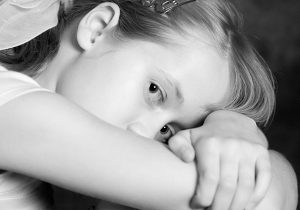What’s Really Keeping You Out of Your Swimsuit This Year

The 4th of July weekend carried a strange theme for me this year. It started when I was driving my 10-year-old niece home from a family pool party and she asked me, puzzled, “Why do so many people hate the way they look?” I realized that she was referring to comments she’d overheard while happily playing in the pool from several swimsuit-clad adults sitting poolside.
Later that weekend, I took this same niece and her cousin shopping for new dresses. As they tried on clothes, my niece commented, “Nothing looks good on me; Sabrina looks good in everything.” It surprised me to observe such a young girl expressing such a poor body image and comparing herself unfavorably to her cousin. And yet, the very next morning I myself was a witness to a similar
discussion between two friends of mine. One, a woman who is enviably slim and fit, casually complained about feeling fat in her bikini at a recent beach party. The other, a man with a near-perfect physique, joined in, saying that since he hit 30, his body was getting “soft and round.”
All of this left me marveling at the prevalence of negative body image. With pool parties, beach trips and shopping excursions in full swing, people were naturally showing more skin. To me this marked a moment of summery celebration, yet for many unlikely candidates, this started a spiral of negative thoughts. Temperatures were rising, while self-esteem was dipping to new lows. The sad truth is that, in peeling off the layers of our wintry wardrobes, we expose ourselves to a whole new world of self-critical thoughts.
People’s views of their bodies are not only cruel but inaccurate. A friend of mine recently told me how down on herself she feels about getting older and confessed how she continually compares herself negatively to “younger, prettier girls.” She showed me an old picture of herself, of the “skinny and youthful” woman she once was. When I asked her how she felt about herself at that time, she remembered that the very day the picture was taken, she’d felt fat, ugly and full of the same self-hate she felt today. It was obvious that her perception of herself as a young woman was as flawed as her current self-image. What she really needed to address wasn’t the wrinkles under her eyes or the grays in her hair, but the underlying feeling of shame that’s long kept her from accepting herself as the attractive woman she truly is.
So what is the underlying cause for the damaging thoughts that we harbor about our bodies? What is the reason for the discrepancy between the critical way we see ourselves and the realistic view that others have of us? Our basic self-perception is shaped by both positive and negative programming from our past. For example, when a parent or other significant adult persists in looking at a child’s face critically, that child will begin to incorporate the thought or believe that that there is something inherently wrong with him or her, particularly his or her physical self.
Early experiences that we never imagined would have impacted our way of seeing ourselves remain the deep-seeded sources for inaccurate self-criticism throughout our lives. People who face issues of low self-esteem can trace them to feelings of humiliation, rejection or disappointment they suffered in childhood. When young children search for the reasons and explanations for these feelings, they often look within themselves rather than finding fault with an adult they are dependent on. One of the easiest places for them to lay the blame is on their physical appearance.
Throughout our lives, many experiences can feed into the deep, old sense of shame that sources from as early as our first few years of life. We continue to assign this ongoing feeling of shame to parts of our bodies that we see in a negative light. Everything from humiliations in front of a classroom, to hurtful break ups, to career failures or even minor mistakes can be attributed to not looking right and add to our inner well of self-hatred.
Too often, we go from feeling negatively about our appearance to actually avoiding certain activities and events, because we’re ashamed to be seen. Thoughts that we are too short, tall or out of shape can keep us from going for a swim or even taking our shirt off at the beach. Our negative body image can also keep us from more meaningful courses of action. For example, we may assume someone we’re interested in is not attracted to us, or we may avoid intimacy altogether, because we are insecure about how we look. When we lose confidence in ourselves, we may resign ourselves to familiar activities and situations instead of pursuing what we really want to do; for instance, staying at home and avoiding a party, because we feel like we are not as attractive as other people who are going.
Each of us harbors our own unique prescription for self-loathing. Therefore, even as we gather in droves at local beaches, parks and summer hotspots, we’re often sheltered in our own bubble of shame, coached by an inner critic that tells us we are different, flawed and lesser than those around us. We even project these self-attacks onto others and think they are critical toward us or not attracted to us. We may notice that our self-attacks get a lot louder in situations where we become self-conscious of our bodies like getting out of the shower or going out at night.
This Critical Inner Voice gives us instructions to hide our bodies. It’s the one that is telling us to leave on our tank tops at the beach. It’s the one whispering to us that, since we are flawed, we should drive ourselves beyond reason to achieve perfection or just give up on ourselves. Even though it may instruct us to exercise or diet, the same voice lures us to take it easy or have that second cupcake. It then punishes us by calling us “weak” or “failures” in a vicious cycle that perpetuates the voice process.
Our bodies are often the biggest target of our Critical Inner Voice. No matter where we stand in life, it informs us of our many imperfections and keeps us from fully enjoying ourselves or relaxing in our own skin. We can choose to starve or feed, hide or reveal ourselves all based on the faulty advice of this inner critic. A colleague of mine, Executive Director of the Mindsight Institute, Dr. Daniel Siegel, poses that the only appropriate attitude to have toward ourselves involves four necessary elements: being curious, open, accepting and loving. In this approach, accepting our bodies is key to accepting ourselves and challenging our Critical Inner Voice is key to accepting our bodies.
When we do decide to challenge our inner critic, we can expect to face some serious anxiety. Acting against these thoughts is not just about confronting a few surface criticisms. Rather, it involves awakening a great beast long-fed on the belief that we are inadequate in some way. This beast may be cruel, but it has also grown familiar to us. Acting against its will by taking our goals seriously and feeling confident in our bodies will rouse this inner critic, which, for a time, will get louder.
However, like the Wicked Witch melting in the Wizard of Oz, the voice will eventually fade into the background. So when it tells us to leave on that tank top, it is important to throw caution (and clothing) to the wind and to remember that this act isn’t just about shedding layers of clothing. It’s about stripping yourself of years of self-hatred, shame and misplaced criticism that just doesn’t belong in the here and now.
Tags: self development, self-esteem, self-understanding, stress management










Leave a Reply
You must be logged in to post a comment.